On the afternoon of November 6, 2015, session three of the “International Economic Cooperation and Development: One Belt and One Road Initiative” was held at the Yingjie Exchange Center at Peking University (PKU).
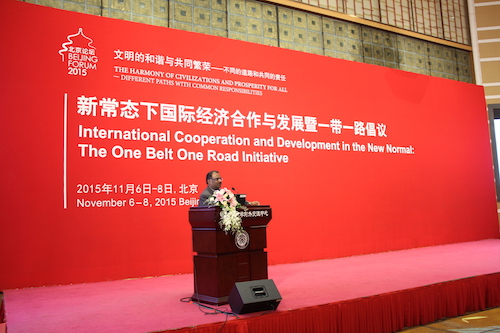
Professor Wang Dashu, Chair of the conference, extended a warm welcome to the distinguish guests. Then Professor Venkatachalam Anbumozhi from the Economic Research Institute for ASEAN and East Asia gave a presentation on the topic of “Powering the Dream with New Economic Normal: Reinforcing Regional Cooperation for Sustainability”. He emphasized that regional cooperation should be based on efficient framework pursuing low-carbon green growth, including infrastructure, business and trade, industry and innovation, finance and investment. As public financing remains a key for innovations on sustainability, actions for pushing the regional cooperation frontier should be taken, for example, establishing a regional low-carbon fund to activate such models as ESCOS, starting a formal regional public-private dialogue on the role of integrated carbon market, launching a regional knowledge platform for capacity building, etc.
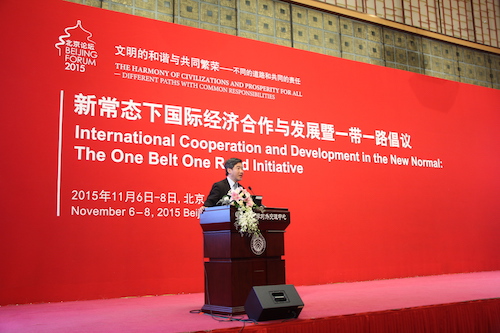
As for the establishment of new normal, Professor Venkatachalam showed the GDP data of Asian countries and explained the crucial role of leadership in seeking sustainable development in new normal to turn conventional growth to low-carbon growth. Besides, the effective governance of sustainability challenges requires joint effort among nations instead of creating a new institutions. As for China, the largest consumer of energy and the world’s workshop, it still remains to be seen if the giant could shoulder the responsibility and achieve the goal of sustainable development.
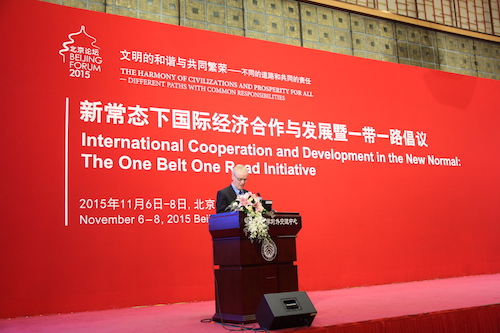
Then, Atsuchi Masuda, Chief Analyst of Japan Credit Rating Agency Ltd., focused his speech on international economic cooperation. He raised a severe problem that current budgets constrained the Japanese aid program. To figure out a solution, he talked about regional integration, such as South America’s Infrastructure Integration (IIRSA), which Japan could gain experience from for ASEAN integration and take advantages of rapid growth of the private finance as well as income disparity among Asian countries. He also attached great importance to monitoring, a fundamental factor and safeguard of regional cooperation.
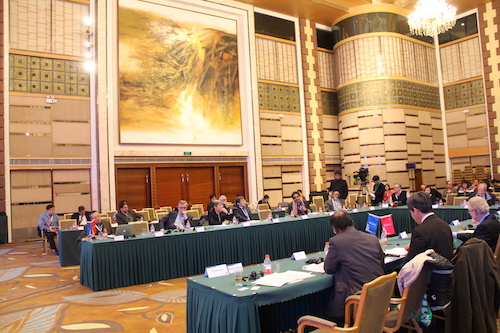
The challenges and solutions of the One Belt One Road inaitiv were explained. After explaining the indispensable grand vision, Professor Masuda raised the top priority—institutionalizing the economic integration in the targeted region. Also, a mechanism to address the regional disparity issues would play a critical role in securing the sustainability of the economic integration, and all sorts of the financial resources needed to be mobilized.
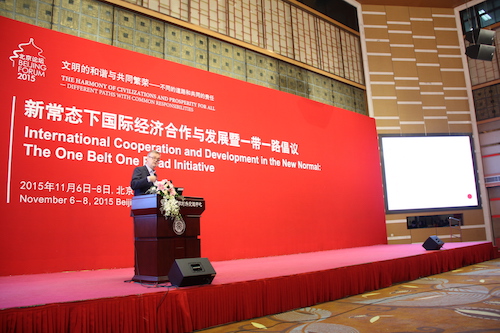
The third speaker was Brian Wright, Professor from University of California, Berkeley. He firstly analyzed the metaphor literal concept of the One Belt One Road and then focused his speech mainly on the function of roads. According to his talk, the effects of roads were complex and difficult to measure, the strategy was to simplify the environment, using the sample of typical autarkic rural areas. Then he used examples of the Qingzang Railway and Africa Road to illustrate that distributional effects differed by region and welfare could be gained from specialization enabled by roads. Overall, there are always benefits and shortages of roads. A road complements some market activities, such as specialized market production, but substitutes for others, such as subsistence production. “Some people gain and some people lose.” Professor Wright concluded, “A road plays favorites.”
Then Professor Yu Jiantuo from the China Development Bank Institute talked about some concept issues. The One Belt and One Road had historical accumulation and is excavated nowadays at the right time and right place. After the international finance crisis, the global economy went downhill while Chinese economy entered a new normal, becoming the primary contributor to the global economic growth.
However, the concept of the One Belt and One Road was doubted as a new “Marshall Plan”. Compared with the “New Silk Road”, the initiative raised by China has its own features and advantages, which is to seek the new international economy order and allow all participants to have equal rights and choices, instead of guiding by ideologies. In this way, complementary advantages can be utilized to activate resources.
Moreover, there are still challenges in the process of constructing relevant frameworks. Technique challenges are visible, while deep challenges including weak economic foundations and governance capacity, collision of interest demands, and different culture and values, still need deep-going thoughts.
After a tea break, Professor Biswa Bhattacharyay from the University of International Business and Economics (India) delivered a speech around enhancing Asian infrastructure connectivity. As fragmented institutional arrangements and heterogeneity of market-led integration among countries call for a pan-Asian approach with a new Asian institutional framework, he suggested setting up a pan-Asian coordinating body called the “Asian Infrastructure Coordination Forum (AICF)”.
Afterwards, Professor Tor Eriksson from Aarhus University (Denmark) talked about intergenerational inequality of health in China. Trying to seek a deep mechanism behind the high inequality, he used practical data and economic formula to show the relations among education, health, and the economy.
According to his research, the influence of parents’ socio-economic resources on their offspring’s health reduces, showing general improvement in health and reduction of urban-rural health gap. Meanwhile, poor child health in rural areas has strong negative effects on children’s performance in early school years (with subsequent spillover effects into labor market).
Professor Lee Shu Kam and Professor Kai-yin Woo from Hong Kong Shu Yan University shared their research result in their presentation entitled, “Evaluation of the One Belt, One Road Initiative through the Lens of Nonlinear Adjustment Analysis in Real Exchange Rates”. They identified the list of countries to which China should give priority to form an economic union with.
The last speaker Professor Liu Minquan from the School of Economics in PKU analyzed development aid and social movement. He pointed out that whether money was spent on real assistance that reached the countries could hardly be measured precisely, and the evaluation and assessment of donation was only nominal. Then he raised two solutions, to strengthen “ownership” (sense of ownership and accountability-seeking) of not only host-countries but also honor-countries, and to decentralize the process by involving the public as monitor besides of the power of government.
At last, the floor was opened to questions.
Written By: Wei Yuchen
Edited By: Liu Xiya



